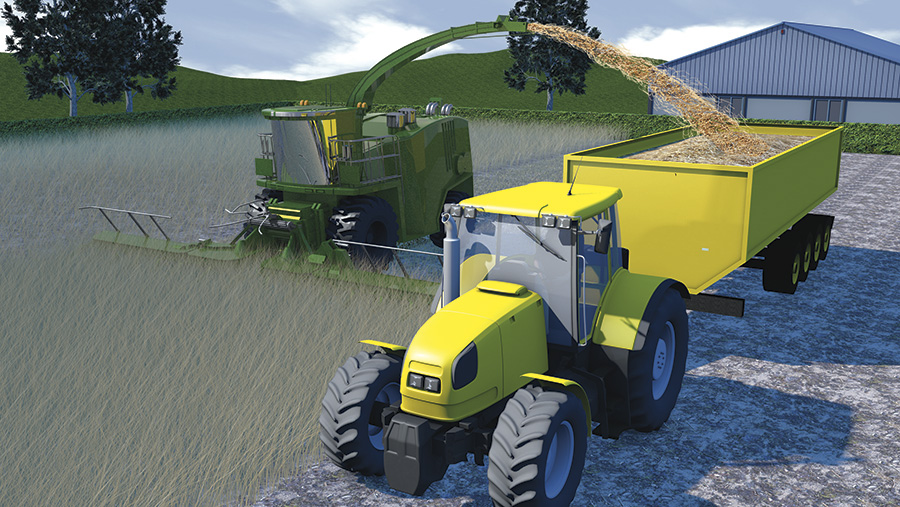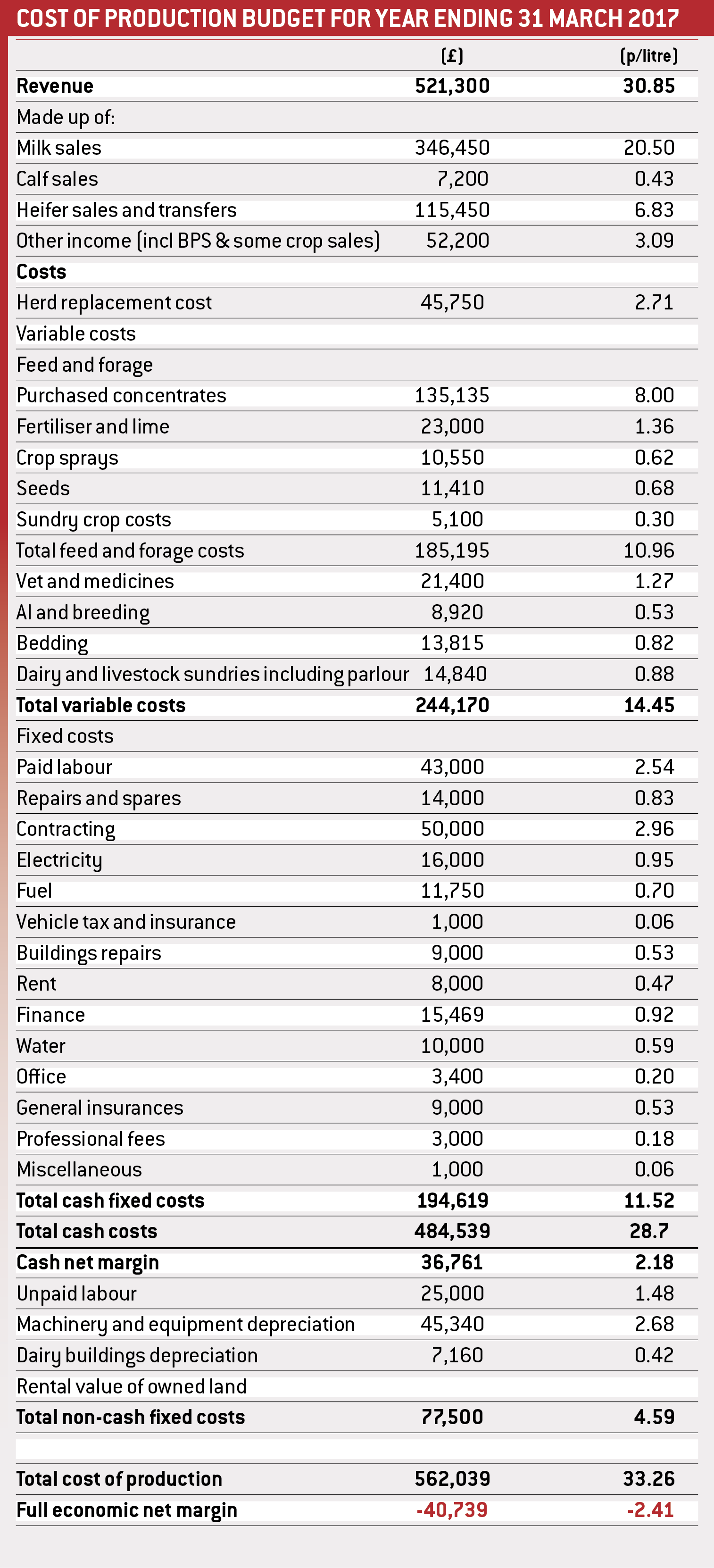Low milk prices challenge virtual farm’s expansion plans
 © Paul Wootton
© Paul Wootton The challenges on the Savills model dairy farm are similar to those faced by many milk producers. Suzie Horne reports on how low milk prices have affected plans to expand the herd
Low milk prices have had a serious impact on cash availability at the 200-cow Savills model dairy farm.
As on many other holdings, this has forced the family partnership to review the business, including its three-year plan to expand from 200 to 300 cows.
See also: Business Clinic: Ways to lower dairy replacement costs
Some costs have been reduced, but not by enough to be able to manage cash requirements.
“The situation the model dairy farm is in is a common one – it is not the size of the loss it will make this year but the availability of cash that presents the biggest immediate challenge,” says consultant Adrian Matthews of Savills Food and Farming team.
Trading loss
Budgets prepared in March this year, based on a milk price of 20.5p/litre, showed a trading loss of more than £20,000 before private drawings of £25,000 and loan repayments of £54,000, which are due this year.
This would have the effect of increasing the overdraft requirement by more than £110,000, pushing it above £130,000.
This increase is equivalent to 4.5p/litre of milk output, a cash figure the business plan would not deliver to cover its capital commitments.
Part of this was due to the planned increase in herd size, which would have tied up working capital.
So the family reviewed the business, and its plans, and found:
- The balance sheet is strong, with net worth of more than £4m.
- The long-term strategy is still the best option for the family to remain farming.
- The trading loss of £20,000 in itself is not severe, but a cash deficit of £110,000 would be. If the current year’s budget was repeated for the year to 31 March 2018, there would be a further cash shortfall of a similar amount and so very quickly the business would have close to £250,000 additional debt.
- If the original business plan of 300 cows is revised and based on an average milk price of 25p/litre instead of the original 28p/litre, although the business will be profitable, the cash surplus will be eliminated and the farm will not be able to afford any additional debt.
- The business has to look for ways to manage the cash position.
“The milk markets and associated production costs have meant the family has had to really challenge all enterprises and costs of production, as well as challenging the original strategic plan to expand the herd to 300 cows,” says Mr Matthews.
“They need to be confident that they can still achieve what was set out.
“Milk price has remained static this summer overall – at least now there are signs that the bottom has been reached but recovery will take some time.
“Some costs, such as feed, fertiliser, fuel and the cost of borrowed money have eased a little, but not enough to offset the fall in milk price.
Budget shock
“The preparation of the initial budget and the realisation the business would be generating a loss and significantly increasing the overdraft was a shock for the family.
“This led them to question their long-term strategy and whether the plans and investment made a few years ago were right for them,” says Mr Matthews.
Following the review, the plan is still to expand, but at a slower pace until the family can be sure of the future (see ‘Model dairy farm plan’, below).

© Paul Wootton
Model dairy farm plan
- Sell some surplus stock – 50 head will be sold in total. This will be made up as 20 additional culls plus 15 in-calf heifers and 15 bulling heifers. This means herd size will increase to 215 head by the end of the financial year instead of the original plan to go to 250 head by then.
- Heifer numbers in the pipeline will be reduced slightly from a planned 253 head to 238 at the same time.
- The sale of heifers and cows will delay when the target of 300 cows is reached by a year, to 2018-19
- Harvest the farm’s winter wheat as a grain crop for cash sale rather than as whole crop silage. This is budgeted to give a cash injection of £16,500 based on sales from 20ha of wheat
- Possibly sell some maize. Rather than put this in the budget, all the maize will be harvested and a view taken a view on stocks later in the winter. This could either allow some crop to be sold, retained as a buffer, or carried forward to the next winter and additional arable crop established.
While these changes will have little impact on the overall budgeted loss, improving it by £5,000 to a loss of £16,000, there is a far more significant effect on the overdraft, says Mr Matthews.
It will mean an increase of about £51,000 at the year end to £70,000, representing an improvement of £60,000 from the original budget and a level which the family feels is manageable.
Model dairy farm’s winter challenge
This winter the family will work on how to increase milk from forage, after the business review also highlighted scope to improve technical performance, potentially increasing output without increasing costs.
The herd feed rate is 0.33kg/litre, with a yield from forage of 2,500 litres a cow. Increasing this to 3,000 litres a cow without changing the purchased feed cost would add 100,000 litres of output. This is a realistic target, says Mr Matthews.
Savills model dairy farm – what is it?
- A fictional dairy farm, fully costed and based on dairy businesses advised by Savills. This allows scenarios to be modelled and their impact assessed.
- Family partnership of parents and son
- 180ha farm, mainly ring-fenced
- 160ha owned, 20ha on 10-year Farm Business Tenancy
- One full-time employee
- All Grade 3 medium/heavy soil type on undulating terrain
- Total long-term borrowings of £428,000, made up of a loan taken out several years ago to buy bare land adjoining the core farm (at £178,000), plus a more recent loan of £250,000 for investment in improvements to dairy facilities
- Rainfall 760mm, altitude 125 – 180m
- In a nitrate vulnerable zone
Savills model dairy farm – the dairy enterprise
- 200 cow, 8,000-litre high output system
- Year-round calving
- Performance in line with AHDB top 25%
- Milk price of 20.5p/litre is also the milk price in this year’s budget (31 March year-end). It has been lower earlier in the year and an expected further improvement from this month of 1 -2p/litre gives the 20.5p/litre budgeted average
- Investment in new parlour, bulk tank and additional cubicles in 2013-14
- Original plan to expand to 300 cows in 2017-18 has been thrown into doubt by the dairy downturn
Recent business history
Following a review of the business three years ago a decision was made to build up the dairy business.
This was through a long term investment plan and to rear additional heifers to grow the herd from own breeding to 300 cows.
Budgets were prepared, assuming a milk price of 28p/litre. These showed a profitable plan and that there would be surplus cash to repay the loans that would be required for the expansion.
The total cost of expansion was estimated at £400,000 in facilities, plus additional working capital in the region of £150,000 related to the extra cows.
An initial £250,000 was committed and spent on the parlour, bulk tank and some of the cow accommodation. Further expenditure would be required as the herd expansion progressed.
Sensitivity applied to the budget showed that the plan could work at a milk price of 28p/litre, about 4p/litre less than the milk price being paid when the plans were prepared.
During the current financial year (to 31 March 2017) the business expected to continue to expand the herd so that by the year end it would have grown to about 250 cows. This was planned to increase further to 300 head by March 2018.

